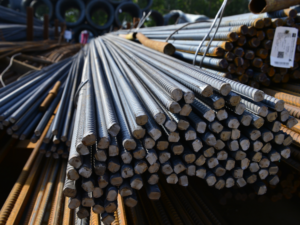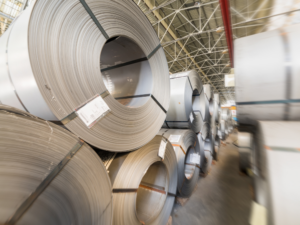The European hot-rolled coil steel to raw materials price spread edged up 1% in February, rebounding after January’s significantly fall, as steel prices outpaced a rise in coking coal, iron ore and ferrous scrap, according to an analysis by S&P Global Commodity Insights March 1.
The Northwest European HRC steel-raw materials spot spread rose to Eur538/mt ($602/mt) in February, from Eur532/mt in January. The spread had fallen from a record of over Eur795/mt in August, as costs steadily increased, according to S&P Global calculations.
Following Russia’s invasion of Ukraine, market participants are monitoring its impact on steel raw materials availability in Europe. Shortages could lead to potentially higher operating costs, exacerbated by declines in hot metal rates.
European steelmakers strongly depend on the ongoing supplies of PCI coal, or pulverized coal injection, and iron ore pellets from Russia and Ukraine.
Along with steel market demand and forward sentiment, how European steel pricing reacts to steel prices in surrounding markets, which have risen quickly due to a drop in Black Sea steel exports, may determine how margins respond to any cost pressure.
While the indicative NWE steel margin has continued to decline from August, stronger-than-average HRC prices have supported available cash cost margins above typical steel industry levels, according to S&P Global data.
Spot HRC prices have increased supported by higher European mill offers for production and deliveries in the second quarter, and contract demand.
Coking coal prices hit record highs in February, while iron ore prices rebounded. Pellet and lump premiums, high-grade fines and concentrate prices and demand got support from wider 62%-65% Fe fines spreads and buying interest in lower alumina ores.
Higher raw materials costs further boosted the overall cost of pig iron produced in Europe, as higher European shredded scrap prices lifted steel costs.
S&P Global tracked costs using major steel feedstock cost references, including a basket of iron ores with high-grade fines, lump and pellets typically consumed by NWE blast furnaces.
HRC, iron ore prices rise
The NWE HRC spread averaged around Eur645/mt in Q4, down from Eur771/mt in Q3 and Eur695/mt in Q2, according to S&P Global.
Platts NWE HRC prices averaged Eur959.25/mt ex-works Ruhr in February, up 3.5% from January. In July, monthly average pricing hit a record high of Eur1,172.64/mt ex-works. Platts NW Europe HRC was assessed at Eur960/mt ex-works Ruhr Feb. 28.
Spot prices for commodity-grade HRC are not fully reflected in sales and deliveries by steelmakers, due to earlier negotiated pricing terms and long-term contract pricing.
Iron ore import prices in China, used as a benchmark for global contracts, rose further in February on stronger forward demand and interest in securing higher quality products.
Prices averaged $141.99/dry mt CFR China for benchmark Platts IODEX 62% Fe fines, up 8.3% from January.
Spot lump ore premiums in China rose 24% to 34.16 cents/dmtu, or around $21.35/dmt, in February, more than double the lump premiums in November and December.
Platts Atlantic blast furnace contract pellet premiums in February remained at $66.50/dmt, tracking contract premiums and pricing terms settled for Q1 volumes. Premiums rose from Q4 average of $55.50/dmt.
Coking coal prices on a delivered net forward basis into Rotterdam in February rose 8.9% to $460.31/mt CFR Rotterdam, a record high for the price reference using Capesize vessel rates from Queensland.
Regional northern European shredded scrap prices increased to Eur430/mt last month, from Eur405/mt delivered basis in January.
China, US spreads
In China, the spread between HRC export prices and imported iron ore and coking coal costs rose to $335.48/mt in February, from $313.31/mt in January, on higher steel prices.
Even with higher raw materials costs, a mix of supply disruptions and steady demand for steel in various sectors is keeping prices and offers relatively strong, with stronger indicative profitability.
China HRC spreads remain stronger than a year earlier, and higher than 2020 levels, which were below the $300/mt mark.
The unraveling of record-high flat steel prices in the US back toward levels in other global markets punished indicative margins. US HRC to Midwest shredded scrap spreads fell sharply to $678.41/st in February, from $966.98/st in January.
US flat steel prices declined, moving in line with HRC in Europe and other regions.
S&P Global’s Europe HRC to raw materials price spreads are indicative operating margins that do not account for inland logistical costs, power, natural gas or other blast furnace and steel-making inputs, such as ferroalloys, anodes, and refractories. Costs to operate sintering and coke plants are not included.
There may be further upward pressure on typical operating breakeven levels at regional blast furnace mills, due to higher energy, carbon permit, and logistical costs.
Before the pandemic, an HRC-raw materials spread of Eur250/mt was described as close to operating breakeven for commodity grade steel, based on operating facilities at higher capacity utilization, according to steel industry sources. However, with higher logistics, trade financing, operating, and facilities costs stemming from the sudden shutdown of furnaces and mills in 2020, industry costs have risen. In 2019, the Northwest European HRC spread averaged Eur241/mt.
Breakeven levels in Europe are partly dependent on the mix of logistical costs and raw material configurations.
S&P Global’s estimated European HRC spreads are based on commodity-grade flat steel specifications. Contract steel sales may have additional grade- and specification-based premiums, and terms may lag spot indexes.
Producers with higher grade steel portfolios may be less exposed to commodity-grade steel margins against underlying steel raw materials costs.
— Hector Forster






